
The Vizsla, also known as Hungarian Vizsla, Magyar Vizsla or Hungarian Pointer, is a dog breed from Hungary and belongs to the Fédération Cynologique Internationale (FCI) group 7, the Canadian Kennel Club (CKC) group 1, and the American Kennel Club. The Hungarian or Magyar Vizsla or Smooth-Haired Vizsla are sporting dogs and loyal companions. The Vizsla's medium size is one of the breed's most appealing characteristics. As a hunter of fowl and upland game, the Vizsla has held a prominent position among sporting dogs – that of household companion and family dog.

A herding dog, also known as a stock dog or working dog, is a type of dog that either has been trained in herding livestock or belongs to one of the breeds that were developed for herding. A dog specifically trained to herd sheep is known as a sheep dog or shepherd dog, and one trained to herd cattle is known as a cattle dog or cow dog.

Collies form a distinctive type of herding dogs, including many related landraces and standardized breeds. The type originated in Scotland and Northern England. Collies are medium-sized, fairly lightly-built dogs, with pointed snouts. Many types have a distinctive white color over the shoulders. Collies are very active and agile, and most types of collies have a very strong herding instinct. Collie breeds have spread through many parts of the world, and have diversified into many varieties, sometimes mixed with other dog types.

The Rough Collie is a long-coated dog breed of medium to large size that, in its original form, was a type of collie used and bred for herding sheep in Scotland. More recent breeding has focused on the Collie as a show dog, and also companion. The breed specifications call for a distinctive long narrow tapered snout and tipped (semiprick) ears, so some dogs have their ears taped when young. Rough Collies generally come in shades of sable and white, blue merle, tri-coloured, and colour-headed white.

Dog communication is the transfer of information between dogs, as well as between dogs and humans. Behaviors associated with dog communication are categorized into visual and vocal. Visual communication includes mouth shape and head position, licking and sniffing, ear and tail positioning, eye gaze, facial expression, and body posture. Dog vocalizations, or auditory communication, can include barks, growls, howls, whines and whimpers, screams, pants and sighs. Dogs also communicate via gustatory communication, utilizing scent and pheromones.

The McNab Dog, also called the McNab Shepherd or McNab Collie is a herding dog that originated in Hopland, Mendocino County, Northern California. The McNab was bred to withstand the tough conditions found in California such as heat, burrs, foxtails, and rugged terrain. Until recently, the McNab was little known outside California, but in last three decades have seen a gain in popularity and geographic dispersal of the breed.
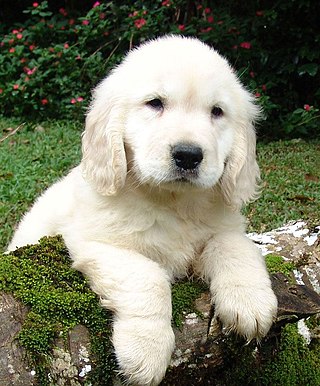
A puppy is a juvenile dog. Some puppies can weigh 1–1.5 kg (2.2–3.3 lb), while larger ones can weigh over 7 kg (15 lb). All puppies display primary altriciality and healthy puppies grow quickly after birth. A puppy's coat color may change as the puppy grows older, as is commonly seen in breeds such as the Yorkshire Terrier. Puppy refers specifically to young dogs, while pup may be used for other animals such as wolves, seals, giraffes, guinea pigs, rats or sharks.
Mist: The Tale of a Sheepdog Puppy is a British family television film following the life of a border collie puppy as she grows up to become a working Herding dog. Part fiction, part documentary, it was filmed by real-life shepherd David Kennard on his farm in Devon. It features his seven working dogs - the puppy Mist, her gentle mother Gail, grandfather 'Sir' Gregory, eccentric, bubbly, hyper uncle Jake, sour and negative great-auntie Fern, gruff, tough cousin Ernie and wise auntie Swift.
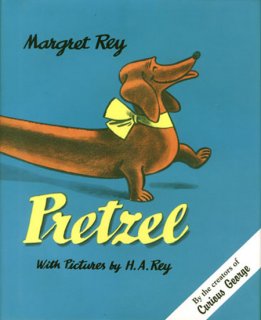
Pretzel is a children's picture book written in 1944 by Margret Rey, illustrated by H.A. Rey and first published by Harper & Brothers.
Kyra Sundance is a dog trainer, performer, and author.

Pound Puppies is an animated children's television series developed by Wendy Klein Moss, Nancy Steingard, Paul Germain and Joe Ansolabehere for the Hub Network. It premiered on October 10, 2010 in the United States as the first Hub "original series". It also aired on YTV in Canada and on Boomerang in the United Kingdom, Ireland and Australia. Produced by Hasbro Studios, it was the second series to adapt Pound Puppies into a cartoon format. Originally a property by Tonka, Hasbro acquired Tonka itself and currently manages Pound Puppies. The plot style and music were similar to the 1960s TV series Hogan's Heroes and to films like Stalag 17 and The Great Escape. The first seven episodes of the series were animated by 9 Story Entertainment, but DHX Media/Vancouver took over to animate the series from episode 8 onwards.

Bolt is a fictional character and the titular protagonist of Walt Disney Animation Studios' 2008 film Bolt. He is depicted as a White Shepherd with superpowers such as a "super bark" and the ability to shoot lasers from his eyes. When he found himself lost, Bolt discovered that he was an actor in a television show, and must take it upon himself to get back home, learning how to be a normal dog in the process. Bolt's journey and personal evolution as a character are core to the film's main themes.

Beverly Hills Chihuahua is a Mexican-American film trilogy. The films are based on a chihuahua named "Papi" going through adventures alongside his family and friends.

Sherlock Bones, also known as Sherlock the Detective Dog or Tanteiken Sherdock in Japan, is the story of a young teenage boy who adopts a dog from the pound. Once the young boy discovers that his dog can talk with his grandfather's old pipe, they go on adventures and solve crimes. The story was created by Yuma Ando with art by Yuki Sato. The manga was released in Japan in 2012 and translated to English officially in 2013.
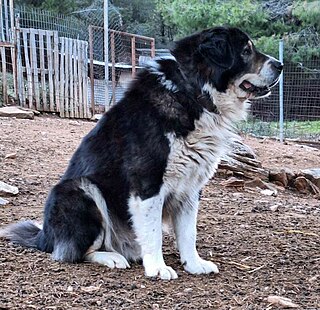
The Greek Shepherd or Greek Sheepdog is a breed of livestock guardian dog from Greece. Thought to be ancient in origin, the Greek Shepherd is very closely related to livestock guardian dog breeds from neighbouring countries; it is believed that some dogs are simultaneously claimed to be other breeds as they migrate annually across national borders with the flocks they protect in search seasonal pastures.
The Seventh Brother is a 1995 Hungarian-German-American animated fantasy-comedy-drama film for children made and produced at Hungary's Pannonia Film Studio. It was co-produced with Magyar Televízió, Germany's RealFilm, and the U.S. outlet Feature Films for Families.
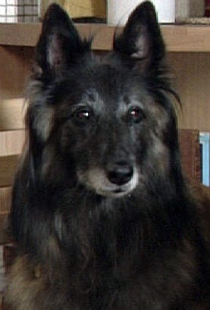
Wellard is a Belgian Tervuren dog from the BBC soap opera EastEnders. His character first appeared in the series on 18 October 1994, and became EastEnders' longest-serving pet, before being killed off on 15 August 2008. Although the character is male, he has been played primarily by three female dogs: Zenna, her daughter Chancer, and her granddaughter Kyte. A fourth dog briefly served as a replacement for Zenna in 1996, when she was given time off from the show to have a litter of puppies.
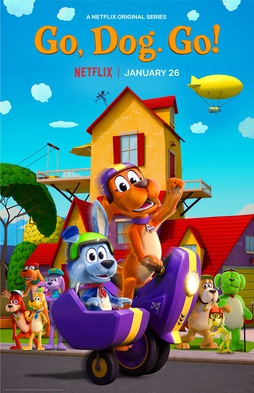
Go, Dog. Go! is an animated children's educational television series based on the 1961 children's book of the same name by P. D. Eastman, which was developed for Netflix by Adam Peltzman.
Canine Intervention (Canine Academy) is an American Netflix original TV show/reality show of 6 episodes of about 35 minutes each. Originally a web-series, the premiere on Netflix occurred on February 24, 2021. The show takes place in Oakland, California. It deals with dog training, through the main protagonist, Jasalah Leverette and his dog training facility, Cali K9 in San Jose. Each episode displays Leverette coping with specific cases. The show is directed by Elise Duran and produced by the A.Smith & co-Productions company.















